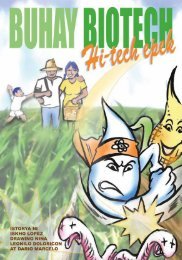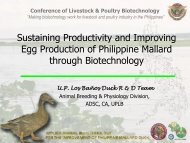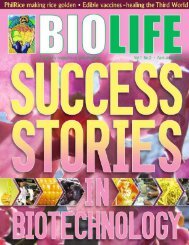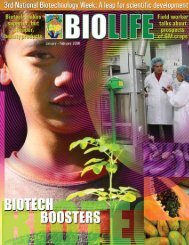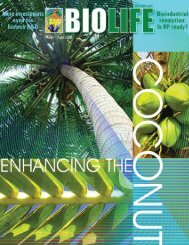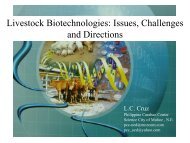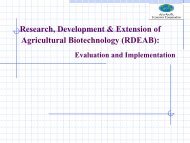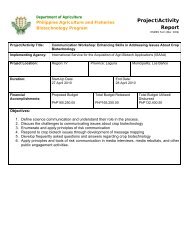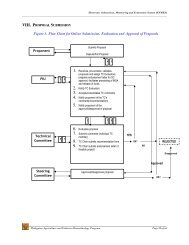Download PDF - SEARCA Biotechnology Information Center
Download PDF - SEARCA Biotechnology Information Center
Download PDF - SEARCA Biotechnology Information Center
You also want an ePaper? Increase the reach of your titles
YUMPU automatically turns print PDFs into web optimized ePapers that Google loves.
January – March 2005 BIO LIFE<br />
33<br />
Farmers shifting to new corn technologies<br />
Typical Bt corn harvest.<br />
From page 19<br />
the corn fields. He likened the corn borer to<br />
a “natural calamity” or typhoons.<br />
Jay Narciso of Arayat, Pampanga, considers<br />
himself adventurous and decisive.<br />
Narciso has spent almost half of his life<br />
working abroad. He has worked in Riyadh,<br />
Saudi Arabia, on the staff of the Saudi Arabian<br />
Interior Minister. After seven years,<br />
he moved to Switzerland and stayed in Europe<br />
for six years, after which he decided<br />
to return to his native Pampanga.<br />
Being a son of farmers, Narciso decided<br />
to invest his earnings in corn farming. He<br />
started purchasing two tractors and ventured<br />
into modern farming practices, initially by<br />
planting conventional hybrid seeds.<br />
“With these regular hybrids, I would yield<br />
an average of seven tons/hectare, which<br />
to regular standards is above average,”<br />
Narciso said.<br />
Eventually, he decided to upgrade into<br />
Bt corn and planted five hectares of<br />
YieldGard 818. With the new technology, his<br />
yield increased from 9mt/hectare to 10mt/<br />
hectare, which improved his income by about<br />
30 percent.<br />
Farming is not new to another former<br />
overseas Filipino worker, Jesus Gavino, 52,<br />
from the hometown of President Arroyo in<br />
Santiago, Lubao, Pampanga. In his youth,<br />
he used to help his father in the farm during<br />
summer.<br />
Gavino spent 16 years as a heavy-lift<br />
driver in Kuwait and Saudi Arabia. Then, he<br />
decided to come home and venture into<br />
farming. Initially, with conventional hybrids,<br />
he would average 5mt/hectare. Switching to<br />
YieldGard 818 gave him a yield record from<br />
9mt/hectare to 10mt/ hectare.<br />
These farmers agreed that using modern<br />
technologies in corn farming, current<br />
farm yield and income levels could still be<br />
improved.<br />
In South Cotabato, Lanao del Sur and<br />
Isabela, a revolutionary backyard-farming<br />
venture has been changing the lives of<br />
farmers and farming communities since<br />
they ventured into Bt corn and hybrid corn<br />
farming.<br />
Farmers who used to get about an average<br />
of 6.5mt to 7mt of corn from a one-hectare<br />
farm may now be able to harvest 10<br />
metric tons or even more.<br />
Such is the case of Carmelito “Lito” G.<br />
Dinopol, from barangay Topland, Koronadal,<br />
South Cotabato, who has been planting conventional<br />
hybrid corn for the last two years,<br />
starting only with 5 hectares.<br />
Mang Lito used to apply insecticides to protect<br />
his fields from insect pests. But unfortunately,<br />
during the rainy season, the sprayed<br />
chemicals are washed off easily, thus, significantly<br />
decreasing yield, he observed.<br />
From a field tour of a Bt corn demonstration<br />
farm, Mang Lito was able to see for himself<br />
the added value of having corn plants with<br />
built-in protection against corn borer. Trying<br />
the new technology has improved his yield<br />
and, having been encouraged by the good<br />
market price of corn, he is now helping fellow<br />
farmers in his community avail themselves of<br />
the Bt corn technology.<br />
From Wao, Lanao del Sur, Francisco<br />
Piagola used to plant his four-hectare<br />
farm with open-pollinated corn<br />
varieties that yielded only 1.5mt/hectare.<br />
A simple switch to corn hybrids<br />
in the ‘90s dramatically increased his<br />
yield to 4mt/hectare to 6mt/hectare.<br />
As he adopts the latest corn hybrid<br />
introduced in the market, such as the<br />
NK hybrid of Syngenta, his yield level<br />
reached 8mt/hectare to 9mt/hectare.<br />
The prospect of good farm income<br />
enticed Manong Francisco to quit his<br />
8 a.m. to 5 p.m. job to become a fulltime<br />
corn farmer, thereby nurturing the<br />
farm with good farm management<br />
practices.<br />
“I was able to send my children to<br />
school and acquired several pieces of<br />
property,” he added.<br />
In Reina Mercedes, Isabela, in<br />
Northern Luzon, Peviano Soriano, a<br />
former seaman who shifted his career<br />
to farming, likes to try and compare<br />
new kinds of corn hybrids (like those<br />
produced by Cargil Asian, Pioneer,<br />
Cornworld, Syngenta) in his farm. With fertilizer<br />
application, the corn hybrids yield from<br />
6 metric tons/hectare to 8.5 metric tons/hectare.<br />
The experience has been helping<br />
Soriano select which variety is most suited<br />
to his farm.<br />
These farmers believe that with the help<br />
of modern corn farming technologies, such<br />
as improved seeds or planting materials,<br />
fertilization and other recommended cultural<br />
practices, yields of crops, such as corn, can<br />
be tremendously improved.<br />
They all received plaques of appreciation<br />
from the Department of Agriculture and<br />
CropLife Philippines Inc. for successfully<br />
using modern farming technologies that contribute<br />
to the attainment of the objectives of<br />
the National Corn Program.<br />
El Bill R. Madrigal/ <strong>SEARCA</strong>-BIC (Originally<br />
printed in TODAY, Earth and Science Page,<br />
August 31, 2004)




